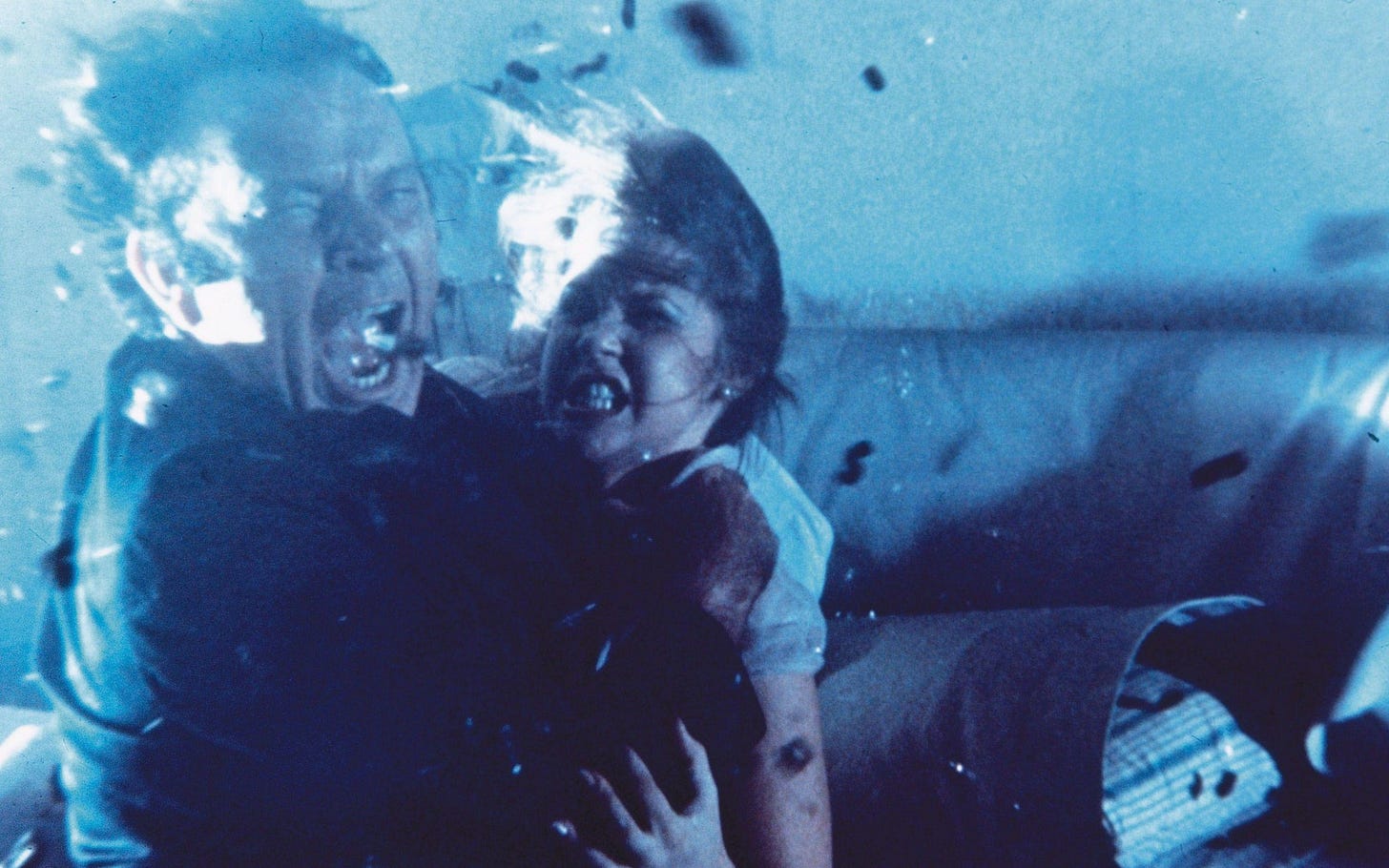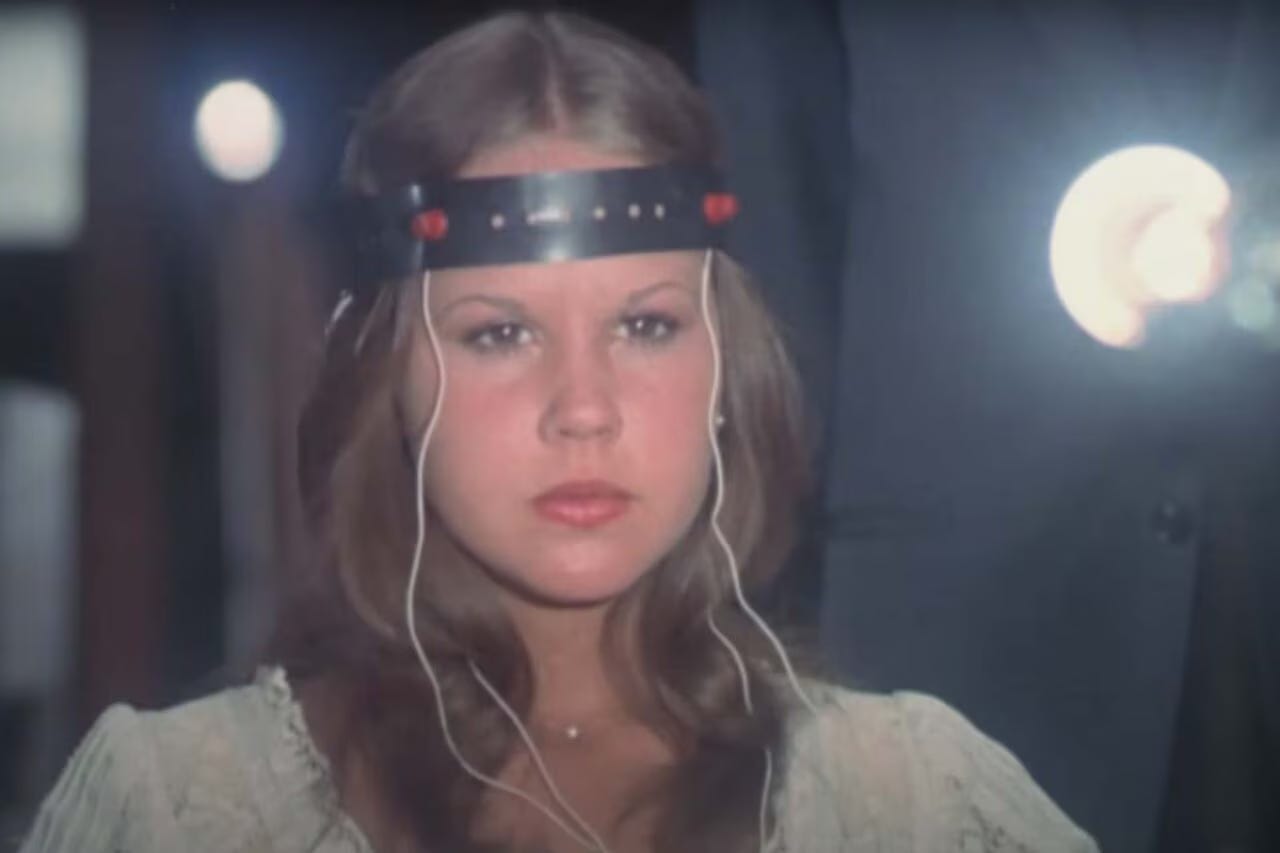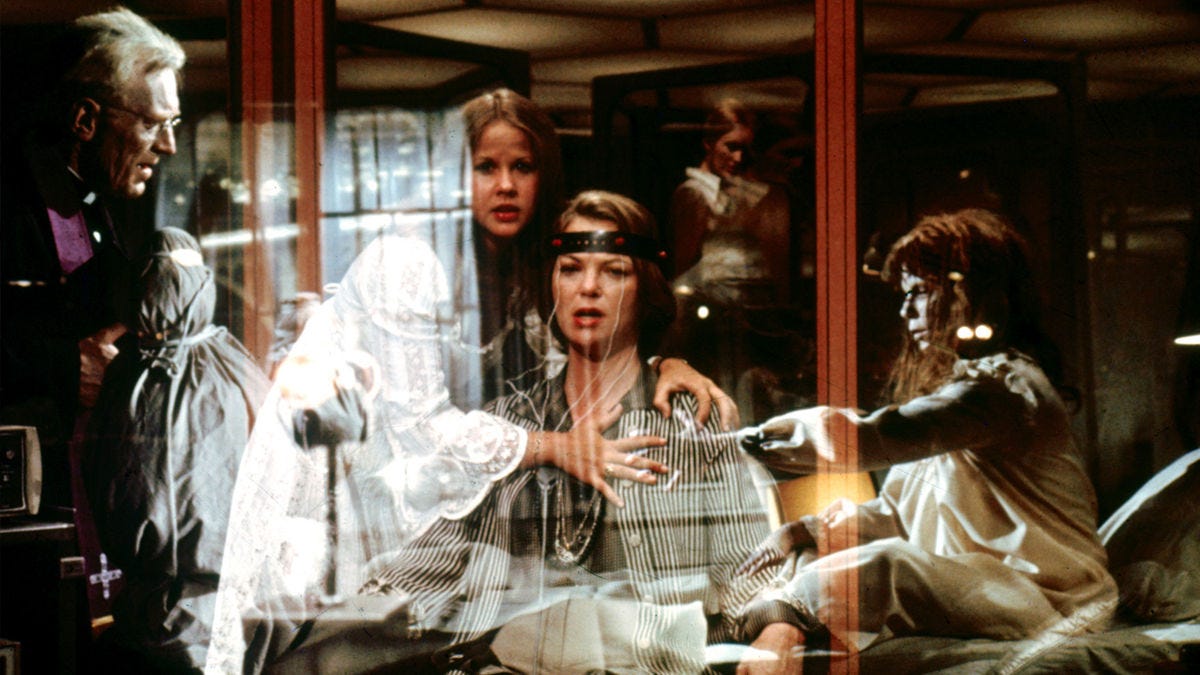CAN WE REPRESS THE MEMORY OF THIS MOVIE?
It’s the most hated sequel ever, but is it time to reconsider The Exorcist II: The Heretic?
At Cinema Dirtbag we believe there is no such thing as a bad movie. There are cheap ones. There are shallow and expensive ones. There are movies that make no sense, or are too personal in meaning for the creator to allow an audience in. But being born of the most grinding art process devised on Earth, every completed and released film is a miracle, proof that human cooperation is possible and that there is cinematic light in all of us.
This faith was shaken by 1977’s The Exorcist II: The Heretic.
We weren’t surprised by that. That the Exorcist sequel was both the most expensive film ever made at the time and a total disaster is part of film lore. So much so a documentary, Boorman and the Devil, is doing the festival rounds this season to ask audiences to reconsider one of the most disliked films in history. It screens next at the Brooklyn Horror Film Festival on October 22nd.
Since neither of us had ever seen the sequel we decided to start our Halloween watches with it.
Heretic is less a horror story and more That ’70s Movie about universal consciousness. Or something. Director John Boorman, the genius behind Point Blank and Deliverance, has long admitted he made a mistake in trying to craft an incredibly sincere riposte to William Friedkin’s original film. (Boorman loathed the novel when he was offered it first.) Adding to the unheimlich nature of the Heretic is that nearly every shot—including the highlands of Ethiopia—was created on airless soundstages, guaranteeing that “1977-ness” was baked into every frame.
While we didn’t become converts, we did reverse engineer how this film went off the rails, and were reminded that misfired talent is still talent any of us would be lucky to have.
Brian J Davis: Unmute it! The polite “I liked the lighting” discussion for this movie is the soundtrack. An insane Ennio Morricone score. Maybe one of his best.
Emily Schultz: So I’ve never seen this. And I can’t believe you haven’t.
BJD: I know! And I grew up in an Exorcist household even. But it was so firm in cultural memory that this was a bad movie we never saw it. I distinctly remember being at the video store with my mom when I saw the box for Exorcist II: The Heretic and I’m like, “I didn’t know there was a sequel! Why haven’t we rented it!” And she just gave me this wordless look then said, “How about Footloose?”
ES: Brian, it was edited by someone whose last name is Priestley. How wrong can it be?
BJD: The number one thing they did that sank this movie is they were rewriting the film on set. Which is pretty much a guarantee that—for a plot-driven movie—you’re going to get something incomprehensible. Richard Burton is about to have a very bad day at work as an exorcist. [A possessed woman sets herself on fire.] After this it’s a bit of a slow burn.
ES: Is it any wonder that growing up I thought religion was weird?
BJD: I guess we have to remind our readers out there that Emily is terrified of religion and annoyed by all Exorcist films.
ES: For some reason we’re jump cutting to the saddest high school musical.
BJD: Linda Blair is only possessed by jazz now.
ES: This is her mom?
BJD: No! It’s her therapist. Louise Fletcher. Most of the original cast didn’t want to do the sequel. So some interesting character choices were made. Max von Sydow actually hated The Exorcist. He said all it proved was that the world hates children. Boorman somehow talked him into coming back.
ES: This is more ’70s looking than you could ever imagine. Wait, did her therapist also play Nurse Ratched?!
BJD: She did. The conceit here is that Regan has no memory of the exorcism and they’re using, more or less, a Dreamachine to access her memories. This movie is so sincere—that’s what struck me on my first watch this week. And maybe that’s why it has fans and what makes people revisit it.
ES: I’ve just never seen anyone smile so much during therapy.
BJD: And now this bizarre therapy clinic is all glass panels.
ES: It’s very stagey. Does it matter at all?
BJD: I think every filmmaker is guilty of thinking their methodology is so very important. Reading the making-of book, the things that John Boorman says out loud are hilarious. When debating with an actress and HMU about what hair the character would have, the actress says she’d have a cut that meant she didn’t have to style it, because she wouldn’t care. Boorman flipped out and yelled, “You’re being literal. Her hair must define the shape she makes on-screen, which is of spiritual torment.”
ES: [Emily snort laughs.] Oh, my torment is represented in my hair every day.
BJD: Directors can think they sound so important saying shit like that but it’s just like bad method acting, it’s not going to be on the screen. Okay, so the church wants Richard Burton to investigate the death of Father Merrin and prove that he had heretical ideas and to absolve them of responsibility.
ES: You got that from the Vatican meeting scene?
BJD: I’ve had to watch this three times to get the plot! I want to go back to when you asked if this hospital set matters at all?
ES: It’s odd that it is so determined. And you can see all these background scenes with children with disabilities. Are they going to fully become characters?
BJD: Not. At. All.
ES: So they’re trying to turn The Exorcist into a story of human goodness?
BJD: And that’s the flaw of this movie. The idea is that Regan is clairvoyant and has healing powers. That’s why Satan was attracted to her and it’s why these priests are drawn to her as well. But what struck me about that BS is it’s actually the kind of studio development they would have done to the first movie if they could have. What’s the reason? Just evil? That doesn’t play. Maybe she has super powers?
[Two characters connect to “the synchronizer,” a device very similar to Brion Gysin’s “Dreamachine.”]
BJD: The mistake is they should be playing some Aphex Twin right now to help. Okay, do you remember the point in the late ’90s where it seemed like everyone had a Dreamachine? That was just something that was normal. You’d go over to someone’s apartment and they would be like, “Want to try the Dreamachine? Just made one.”
ES: Yeah, definitely. Where did you hear about them?
BJD: As you work through all stages of alt culture, you will hit the Burroughs and Brion Gysin section and hear about the machine that would get you high without being on drugs. Which, given the expense of drugs in the ’90s, was a very seductive proposition.
ES: Who’s hypnotizing who?
BJD: I don’t know, but Linda Blair is just a little too casual with letting priests hang around her.
ES: I was thinking that. Hey, brooding Welsh priest I just met. Oh, you can stay during my therapy.
BJD: The bulk of this movie is a one-act play on an experimental set, in which characters are trying to communicate to each other through light and sound. It’s almost Canadian.
[Emily laughs when the demonic Regan shows up in flashback using cheesy ghost glass.]
ES: There’s a lot of interdimensional groping going on in this scene.
BJD: “You won’t remember any of this.” He’s not the first priest to say that. Okay, was that scene the first clue that you’re not watching a normal movie?
ES: It’s pretty bad.
BJD: Okay, Burton says this while looking directly at the camera: “Utterly horrible. Fascinating.” He’s warning us.
ES: “I can’t have that discussion right now!” Because they haven’t written the rest of the scene.
BJD: You don’t need a finished script to make a movie. You absolutely need a finished script to make the most expensive movie made though.
ES: So far it lacks character conflict. There’s really no struggle in the characters, at all. Where are we at right now?
BJD: We’re in Ethiopia on a soundstage. There’s a throwaway line in the first Exorcist that Merrin performed his first—
ES: Wait, this giant moth is kind of awesome.
BJD: It’s a locust. There are no moths in the Bible, Emily.
ES: Sorry. Okay. What is going on?
BJD: It’s a flashback. Kokumo, the young boy there, has healing powers, just like Regan. And in no way is that conveyed clearly by this movie. I know that because of three watches and reading the making-of book. Oh, and the locusts represent the dual nature of humanity. That is literally said later on in the movie!
ES: Is this the same day or does Regan just always wear see-through white dresses?
BJD: White to represent good? Groundbreaking. Okay, let’s examine some basic dramatic failure in this scene where Pazuzu summons her to the ledge of the building. It’s a well done shot, dizzying, but no other character is there to witness it.
ES: Which means there’s just no tension from it. It was just a shot. And every time this film establishes tension, it doesn’t hold it long enough. Wait, why does she suddenly live with her therapist?
BJD: That’s actually Kitty Winn. Her mom’s assistant from the first movie. They were so desperate for actors from the first movie to join.
ES: And they were like, hey personal assistant character from the first movie, please come back and play a major character?
BJD: Exactly. Everything wrong with sequels starts with this movie. And I think that’s why it should be studied. That said… Kitty Winn actually has the performance of the film as the assistant because she’s going so Actors Studio hard later in the movie. Her death scene at the end: “I chose evil!”
ES: I think people not talking to each other and looking off into the space isn’t a mood conducive to a horror film.
BJD: So the director wanted to film in Ethiopia because they have these mountain churches where you have to climb up crevasses to get to them. And they couldn’t film in Ethiopia at the time because of the civil war. These are huge sets they’re traveling up to perform the flashback exorcism.
ES: But there was nothing to set that location up, was there?
BJD: Nothing! I had to Wiki “Ethiopian Rock Hewn Churches.”
ES: But now we have obvious ADR over top of it to explain to us what’s happening. Did he want to tell the Ethiopia story or did he want to tell Regan’s story? Because I think actually that this story might be more interesting of the two.
BJD: This is the crux. This movie is both a bad Exorcist reboot and a bad Exorcist prequel folded into a single unappetizing pea soup. There’s the morally superior “we can make a better film than the original” attitude meeting the “fans really want to know about this character and how they came to be.”
ES: [Reading Wiki] Wait. I didn’t realize John Boorman’s still alive.
BJD: No feelings are being hurt here. John Boorman knows exactly what he did. He said in various ways over the years, “The sin I committed was not giving the audience what it wanted in terms of horror.”
ES: Well, look, she’s not wearing white now.
BJD: Because Regan’s about to show off her powers. Let’s give this movie some due: This scene with the autistic girl talking for the first time? I bawled my eyes out the other night.
ES: You did?
BJD: I did! This shitty movie stole my tears because of this one scene that I’ve lived through. And I could break your heart even more. That’s Dana Plato from Diff’rent Strokes playing the autistic girl.
ES: I thought she looked familiar and now that you’ve told me that it’s like a little mini-Kimberly. Okay, this film should have been about Regan working with kids. So simple. They should have had this feel-good stuff where she finds out that she can work really well with kids. That she has a gift. But then she winds up tormented by her demons from the past, right?
BJD: That was right out of The Player. I think you just pitched an amazingly straight forward, emotionally grounded exorcism film!
ES: And don’t bring in the priest until you need him, frankly.
BJD: I want Richard Burton to walk into all that glass, slapstick style, once in this movie.
ES: I was actually going to say, anyone who knows non-typical children knows they would not be down with a mirror maze of a therapy center. Well, we’re back at jazz high school.
BJD: Thank God one single set-up actually paid off.
ES: It’d be a shame if they had built those cardboard sets for nothing. Whose Ethiopia memory is this now?
BJD: It’s not a flashback. Richard Burton is searching for adult Kokumo.
ES: That’s why he’s saying “Kokumo” a lot.
BJD: [In Richard Burton voice] Take it fast. Take it slow. That…is where I want to go. Kokumo. Sorry! I promised I wasn’t going to Mystery Science Theater this talk.
ES: That’s all we can do because there is nothing here. Nothing! There is no active plot!
BJD: But Emily, they’re talking about locust husbandry now.
ES: “The Good Locust,” there you go. This film could have just been a poem.
BJD: That’s a sick burn. Okay, here’s where they tie it all together. Kokumo, the boy with the healing powers, the locusts, Father Merrin, demonic possession. And the woman who died in the opening scene, who was also a healer.
ES: Have they, though?
BJD: No, they haven’t! I think the real conflict of this movie is the commute between New York and D.C.
ES: It’s incredibly poor development if you’re going to have someone direct a sequel to a movie and their pitch is, I hated the first movie.
BJD: One of the flaws of the studio system is it really loves novelty. Not originality. Novelty. Boorman said that and they replied, “Okay, Englishman, you got me listening.”
ES: It’s the climax and they have tension and they always jump to a different scene instead of staying with the tension every single time.
BJD: I’m not going to get too in the weeds, technically, but what I see is the editor desperate to find pacing, because the pacing wasn’t filmed because it wasn’t written in the first place.
ES: So as much as this director tried to escape the first film, now he’s back in that film for this climax?
BJD: Fate is like that. Also, there’s not that much parking in Georgetown.
ES: So now the rest of the movie is basically this stuff, right?
BJD: The shaking bed, the wind, the locusts?
ES: Isn’t that what people come to The Exorcist for?
BJD: They come to think about why there is evil.
ES: What did you come to The Exorcist II for?
BJD: To understand why there are evil sequels.







Whelp, if you want the answers to these and even more questions, BOORMAN AND THE DEVIL is screening at the Brooklyn Horror Fest on Oct 22! Sincerely, the director of BOORMAN AND THE DEVIL (really)